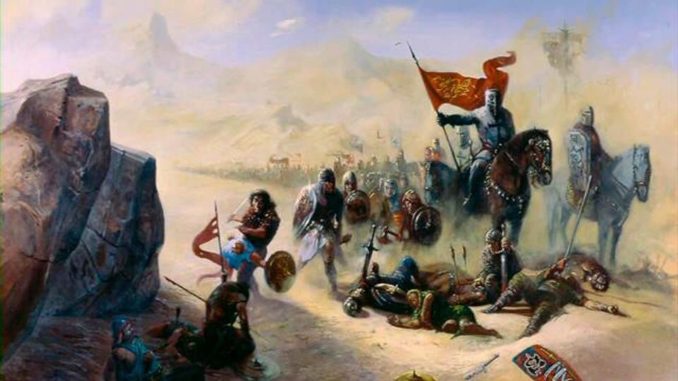
Saxon were one of the leaders of the New Wave of British Heavy Metal (NWOBHM) movement in the early 1980s. They were known for their tough, in-your-face “street” sound and for playing loud, fast, and hard, but also for having music full of melodies and hooks which only made it more potent. They could also delve into more complex arrangements, with songs like Militia Guard and Judgement Day on their first album being almost proto-prog-metal. After that album, though, they focused on a more in-your-face and hard-hitting approach which would make them into one of the standard bearers of heavy metal in the 1980s.
By 1983 the NWOBHM movement was fading, with the bands of that ilk either falling by the wayside or growing past their roots and embracing their own unique sound. Saxon had defined their own success at this point, cementing themselves as one of the leading metal act in Europe and beyond. Their Power and the Glory album from that year was their biggest seller so far, and the arena tour was a huge success. They were also getting a first taste of US success at the time, which was very welcome. The band was riding high, and with their initial record contract with Carrere being fulfilled they were considering where to go from there.
Saxon ended up signing with EMI for 1984 onward. They wanted to take another step up the ladder of success, and a label with more international presence was seen as a plus. The American market clearly beckoned and was in their sights. Their first album for EMI, and sixth album overall, would consequently be a more diverse offering. You could still hear some of that street-tough style of British heavy metal that they had faithfully stuck to so far, but also material stretching out, more melodic touches overall, and (the shock! the horror!) a ballad. The album was released on 30 January 1984, and it was called Crusader.
For all its obvious qualities, fans are often split about this record. Those who liked it would praise the arrival of more epic songwriting (particularly on the title track), the stronger emphasis on melodies and building stronger singalong choruses, and the fact that they could deliver such a diverse album without losing their metal roots. On the other hand, others felt that they had indeed lost their metal roots, and mourned the fact that “their” band now seemed to cater more to US radio than the fans who had been there since the beginning.
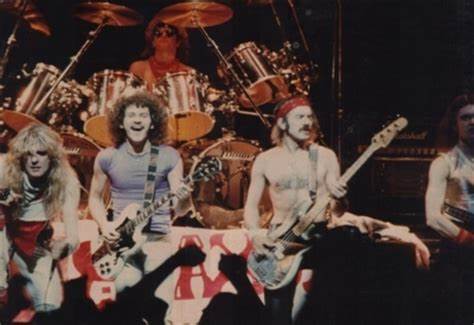
Saxon were perhaps judged harder than other bands for wanting to develop their sound and join in with the 1980s melodic hard rock wave. As NWOBHM had showed, bands that did not develop would fall by the wayside, and Saxon were keen to develop without losing themselves. That wish was hardly unique. Judas Priest and Iron Maiden both experimented with guitar synths and a ligher sound on some of their albums. The initially dangerous Mötley Crüe would attain superstardom when they switched out songs about Satan with songs about girls. Twisted Sister became superstars when they discovered the music video genre and perhaps became more humorous than dangerous. Saxon did not go as far as any of these bands on Crusader, but for fans who wanted no change at all, a little was already too much. Ironically, it can be argued that they did not go far enough, as they were still too steeped in English metal to succeed breaking the glass ceiling in America.
Crusader definitely rang in some changes, but Saxon went much further on each of the three following albums. Innocence Has No Excuse (1985) continues the development towards stadium anthems and melodic rockers. Rock the Nations (1986) features two appearances by Elton John, which perhaps says it all. And Destiny (1988) nearly sealed Saxon’s. After a few wilderness years in the 1990s they found their way back to their strength by the middle of the decade, and have delivered a mix of anthems and powerful, epic metal ever since.
Going back to 1984 and the Crusader album: no matter which side of the fence you’re on about the album itself, there is universal agreement that the title track is one of the best and most popular songs Saxon has ever done.
The title is fitting in many ways. There is the historic aspect, which also inspires the album art, but on some small, subconscious level, Saxon could be seen as modern-day crusaders, heading to foreign shores to conquer new listeners. While that certainly wasn’t the inspiration behind the song itself, it fits the narrative that rose around the band wanting to develop their sound.
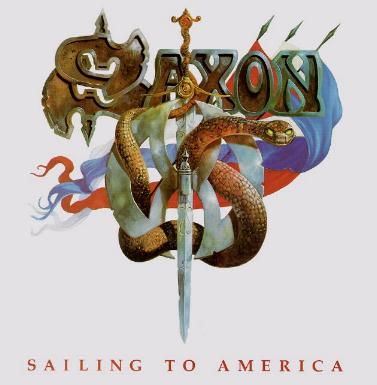
This narrative was further underpinned by the song Sailing To America from the same album, which was also released as a single. In people’s minds, it seemed to confirm what many were thinking – i.e. that Saxon had set their eyes quite firmly on American audiences. “You wanna know what it’s about?” asks Biff Byford. “The Pilgrim Fathers finding a new home. Maybe I should have made it more obvious by calling it Pilgrim Fathers. Besides, we’d been to America loads of times by then, so why on earth would we want to do a song about how we longed to go there?”
People will see what they want to see, and believe what they want to believe. Still, the title track of the album was the one people rallied around, and it struck a chord with both old and new fans. That made the song all the more important.
The song Crusader is about the Christian soldiers who invaded Islamic lands in the 12th Century. It is not a historic account of actual events, but written from the perspective of someone who wanted to go but couldn’t.
“It’s a song written from a young boy’s point of view, watching the knights and soldiers leave for crusade,” vocalist Biff Byford has explained. “And that’s what it’s about. It’s a third-person song, and he wants to go with the knights and his father or his uncles who are going off to the crusade, and he can’t because he’s too young. That’s the idea behind the song.”
Crusader is really the type of song that only an English band could write and perform with a certain level of authority. Songs about war and battle are not unheard of in heavy metal (to state the obvious). Crusader could easily have been a tough, in-your-face song of the type Saxon were known for. Instead, they stretched it out, emphasised the adventure and the legend by shaping it into a more epic-sounding song. It is filled with a mixture of an admiration for the crusader as a hero and a more longing lament for not being able to follow him, all in a very ‘Boy’s Own’ classic adventure style.
To really set the stage for the song, it was given a prelude. Imaginatively called The Crusader Prelude, it opens the album with battle horns being blown. We hear the sound of horses riding and whinnying, warriors crying out and swords clashing. It really gets the imagination going. Eventually, these sounds all die down and all you can hear is a wind blowing – presumably over an empty battlefield. Did they all ride on? Are they all dead? Who knows.
At the tail end of the prelude, you hear Biff Byford calling out “Crusader! Crusader!” in the background, likely representing that young boy who wanted to ride with them. He did not, but perhaps because of that he will now live to see another day. This is chilling stuff to start thinking about. For an album that was supposedly moving in a more commercial direction, this was a pretty brave thing to put in front of it all. If anything, it showed that they were still Saxon.
As we get into the song itself, those quiet winds from the prelude are replaced with a nice guitar-picking melody which eventually morphs into a full opening – a slow, rhythmic, big-sounding part. As it breaks out and changes melody, a deep voice cries out “Who dares battle the Saracen?” (i.e. the Muslims that the crusaders fought). Cheesy? Sure. Cool? Definitely. Along with the entire prelude and build-up, it helps to signal that we are being taken on a journey.
Biff sings insistently about wanting to follow the crusader to the holy lands to “fight the good fight.” The song is comfortably mid-tempo, but with a droning quality and an insistent delivery that gives it a nerve.
Crusader, crusader, please take me with you
The battle lies far to the east
Crusader, crusader, don’t leave me alone
I want to ride out on your quest
I’m waiting, I’m waiting, to stand by your side
To fight with you over the sea
They’re calling, they’re calling, I have to be there
The holy land has to be free
The Saracen returns mid-song so challenge the crusader: “Come crusader, the battle commence!” The following guitar solo is sharp and cinematic, and the sound of swords clashing could easily have returned to accompany that part of the song. A new melody is introduced for the end stretch of the song, with Biff again channelling the boy’s idolised view of the “crusader, the lord of the realm.”
The song is perfectly written and executed. Nobody can claim that it broke new ground in the history of music, but it broke new ground for Saxon.
“It’s what we used to learn at school,” Biff Byford said. “We used to read about the Crusades back in the day, Richard the Lionheart, and all these figures that obviously weren’t as fantastic as people make out they are. People have to remember that England’s history is full of wars and invasions. You know, the Romans, the Vikings. Our whole history revolves around combat. I suppose as a boy, when you read about war and the Crusades and the Vikings, it all seems to be good boy scout stuff. I suppose in reality, it was absolutely brutal and bloody, and billions of people died. When you’re a boy and you’re listening and reading and watching these films, it’s all a bit glorified and a bit ‘marching off to war.’ So, that’s the type of song it is. It’s not making any statements – it’s not anti-anybody or pro-anybody. It’s just a boy watching the crusaders go off to war.”
Bassist Steve Dawson remembers another inspiration for the title: “In England, there’s a paper called the Daily Express, and on the logo at the top of the paper there’s a crusader. There was also a car made by Ford called a Cortina Crusader. That’s what started it off. We just liked the name ‘Crusader.’ We didn’t have any connotations of what it meant as far as history goes. We just wrote the lyrics to fit the title, really.”
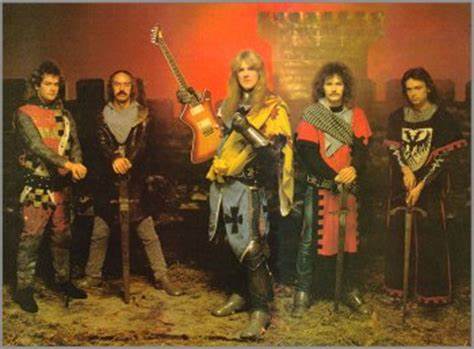
The Crusader World Tour was their biggest yet. The band built a stage set based around a medieval Crusader-like theme. They all wore crusader-inspired outfits. The stage had castle battlements, small towers, and even a fake stone floor. The floor looked great, but was made of lino, which got very wet when dry ice was pumped onstage. Everybody would slip and fall several times during the show. The floor just lasted three or so shows before they got rid of it, but while it lasted, it made for some very funny Spinal Tap-like moments.
“I think people loved us too much,” says Biff Byford today of the backlash that the album got at the time. “Seriously, they felt a lot closer to Saxon than most other bands. So when we made what were considered to be lousy decisions they’d criticise us more than anyone else. We were probably victims, to some extent, of our popularity at the time, and how much we meant to the fans. Yet, despite everything, Crusader is our biggest selling album. You take the figures across our whole career. It’s outsold Wheels of Steel, Strong Arm of the Law… all of them!”
Crusader is a tremendous track – not just a Saxon classic, but an overall heavy metal classic of the 1980s. It has endured in their set lists and is a firm crowd favourite to this day.
Crucially, it also provided a path forward for them later on. The more epic combination of music and storytelling would become what they excelled at from 1995 onward. They would even return to the setting of Crusader with a thematic follow-up of sorts twenty years later on Lionheart (2004), which is yet another very strong album.
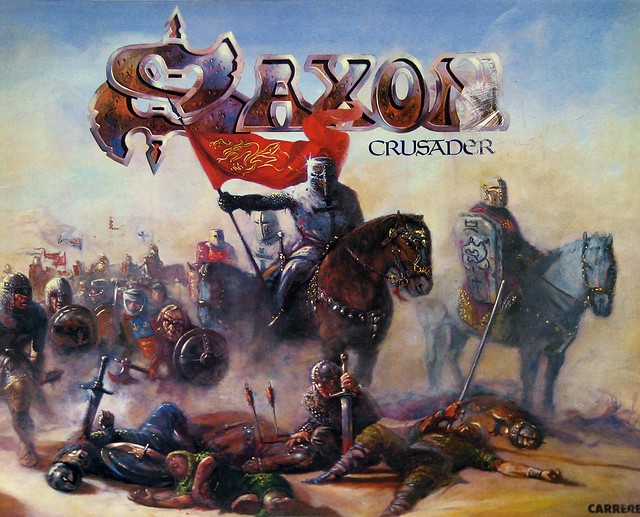

Facebook Comments